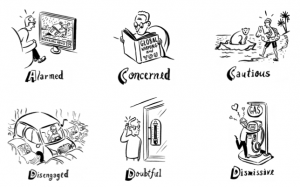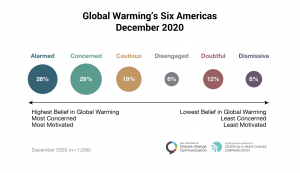4 Communicating about Climate Change
Much of what we do in our classrooms may not be explicitly climate change education, but rather elevating the issue. Climate change impacts populations already disadvantaged and marginalized first and most. Thus, we can also help our students understand the social justice side of climate change by elevating the voices of those most impacted through our examples.
How we communicate about climate change is important. Like all topics that generate controversy, one must not only know one’s audience, but also provide opportunities for self-discovery. Research tells us that we can’t really change people’s minds, but rather, they must struggle with the conflict between evidence and their views in order to “come around” to a new understanding.
Global Warming’s Six Americas

The Yale Program on Climate Change Communication (climate communication.yale.edu) is a great resource for understanding how our students, friends, and families may understand and respond to information about climate change. They report from their research that there is no one public response to climate change, but rather different audiences within society. It is likely that all “Six Americas” is represented in your classroom, in different proportions for different classes and for different years (indeed, the proportions are shifting rapidly).
Below is the distribution based on the Program’s December 2020 survey. Note that there are a relatively small “dismissive or doubtful” population nation-wide. In my own experience at MHCC, I have found that simply presenting climate change information in a straightforward, factual way without “shame” for non-believing, has been enough to shift many doubtful and disengaged students to concerned. Former president Al Gore, in his Climate Reality training, emphasizes that this is the key audience for generating action on climate change. As for effective learning, some anxiety is good as a motivator, but too much leads to shut down. Thus, it is important to not default to “doomsday speak.”

Resources for Communicating Climate Change
In addition to the Yale Program resources, I highly recommend the accessible (with free download) Communicating Climate Change: A Guide for Educators by Anne K. Armstrong, Marianne E. Krasny, and Jonathon P. Schudlt. (available here)

